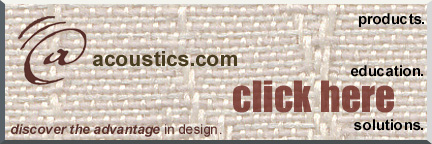
Welcome to Acousticfabric.com,
a collaborative arm of Acoustics.com. This
site aligns with our goals of promoting the importance of acoustics and acoustic-related
issues across a variety of related industries.
What is the Role
of Fabric in Acoustics?
Although fabric alone does not have significant
acoustic properties, it is a crucial component for a variety of acoustic systems.
Acoustically absorptive materials are necessary in a variety of interior environments.
Absorptive materials are commonly incorporated into panels or wall systems. These
types of systems are generally fabric-wrapped or covered by a stretched fabric.
Fabric, in this use, is primarily for aesthetics, but also plays an important
and functional role in covering the absorptive product and allowing sound to pass
through it.
When choosing an acoustic product, designers, architects,
and clients must consider how well the product performs, but also how the product
will look after installation. Assuming that the product will perform as intended
acoustically, the most important aspect of the selection process could be the
look of the product. In most spaces, if the final result is not aesthetically
pleasing, the product is not considered a success. Since most acoustic products
are fabric-wrapped, the aesthetics of the product are often dictated by the fabric
selection.
Why is Fabric Selection Important?
Responsible
designers don't take the fabric selection process lightly. They know that fabric
can play both an aesthetic role and a functional role in an interior environment.
In order to ensure that a fabric performs to expectations, both aesthetics and
functionality should be considered.
There are two primary types of fabric-covered
acoustic products: pre-finished systems, which are fabric wrapped in the factory,
and stretch-systems, which are covered with fabric in the field. When selecting
a fabric for these systems, you are not limited to any one type or look of fabric.
The aesthetic options for these systems are virtually unlimited. However, there
are some fabrics are not appropriate for installation in these acoustic systems.
Fabrics that are not appropriate can puddle from humidity, stretch horizontally
and not vertically, allow the acoustic core to show through, or not allow sound
to pass through.
Why should you care?
If
you choose to overlook these crucial points, the fabric on your acoustic system
could end up sagging, puddling, and rippling, it could allow the acoustic core
to show through creating an unattractive finish, or it could degrade the acoustic
integrity of the entire system. These are just a few of the possible concerns.
Putting forth the added effort to follow uncomplicated guidelines will simplify
your selection process and greatly increase the likelihood that you, and your
clients, will be satisfied with the end result.
What is the Bottom
Line?
Fabric is a very important part of an acoustic system. Choosing
a fabric requires time and knowledge to guarantee the success of your project.
A fabric needs to meet specific minimum requirements and demonstrate particular
characteristics in order to be aesthetically pleasing and function properly.


